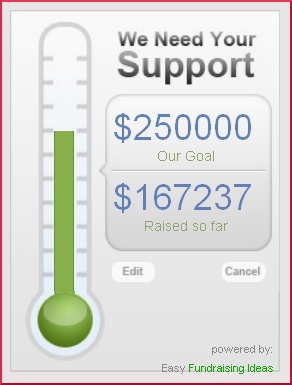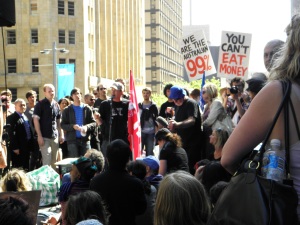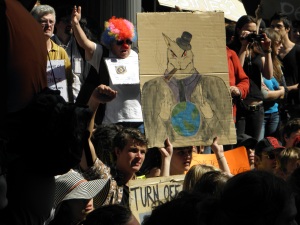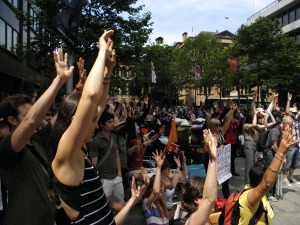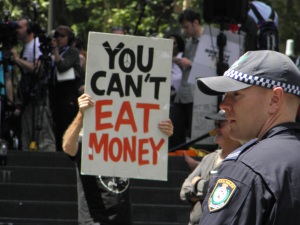
Occupy Perth. Photo by Peter Boyle. Click on image for more pics.
[Talk given to a Socialist Alliance organised forum in the Occupy Perth camp in Forrest Place on on October 30, 2011.]
This quote that has become a bumper sticker, a popular slogan in the feminist movement, the title of many a speech, conference and newsletter is credited to the Afro-American woman civil rights activist Florence Rae Kennedy. She was quoted by Gloria Steinem in Ms magazine in 1973 and since then this powerful slogan has circumnavigated the world many times and being used by many, many activists and movements.
And why do you think this has happened?
It is because this is a slogan that reasonates very strongly with the condition of the oppressed, exploited and persecuted.
On one hand, we are weighed down with the pain of the suffering and indignities inflicted as a matter of everyday business by powerful oppressors. On the other, we are challenged as to what we do in response.
The answer for Kennedy was a single word: “Organise.”
But in reality, for many people it is not that simple a choice. Agonising, the much easier option, is always a big temptation.
Agonising can take many forms. One can just whinge and do nothing. And one can rationalise it with the argument that nothing we can do can make a difference. Nothing is going to change, whatever we do, etc.
Now one can do this rationalising in a simple way like this or dress it up as a fancy theory of some sort. It could be a theory that rejects organisation on principle or it could be a theory that says that “now is not the right time” to organise, that we have to wait till the situation develops further.
But in the end it comes to the same effective conclusion: Don’t get organised now. Just keep doing what you can as an individual.
Or there is a variation on this. Organise but only organise as movements around particular issues like workers’ wages and conditions, climate change, racism, sexism, homophobia or war. Don’t organise to change the system, to break the tyranny of the rich and powerful. Don’t organise to build a new system based on sharing and sustainable practices, call it “socialism” or whatever you want.
Experienced activists have always recognised that there is a deep connection between organising the movements around particular issues and organising for fundamental social change. If an organisation purportedly for the second broader objective is not fully enmeshed in the struggles, movements and organisations for specific changes (or “reforms” as they are sometimes called) then it ceases to be what it claims to be and degenerates into a political sect. A political sect invents and obsesses on theoretical differences that justify taking a course that works against building the movements for specific changes.
On the other hand, experienced activists also know that movements around particular issues rise and subside. Sometimes they subside after a victory, if only partial. Sometimes it subsides after a defeat. In both phases, the critical value of organisations and institutions that continue to accumulate and develop activists, that keeps alive the accumulated lessons of the various struggles and seeks to generalise those lessons. Less would survive from each struggle, and new struggles would find it harder and take longer to start up without experienced activists. On a personal level, it takes organisation to keep morale in the phase when a movement subsides.
Human beings have produced many elaborate justifications for many things, but inventing a justification for inaction – for not organising – is a common phenomenon. It’s possible to lend such a justification ostensibly “Marxist” flavouring because Marx and Engels – and others who followed in the tradition of modern socialist thought that they initiated – said that no system can be superseded until the existing system has exhausted all its avenues for social progress.
Until such time, system change from capitalism or socialism will remain just a wish, a hope, a dream.
So one argument is that we haven’t got to that stage yet under capitalism. Revolution is just an idea, a dream.
But no sooner have I said this than it becomes clear than this is definitely untrue. We live in an age of revolution. What has been sweeping the Arab world this year? Revolutions driven by millions of people who have taken to the streets – often putting their lives on the line.
And this is not the first time. There was another wave of revolutions that preceded this at the beginning of this century in Latin America, revolutions that ridiculed the capitalist triumphalism of the 1990s. And before that there was the wave of revolutions that ended the 1970s. Before that there was the 1968 revolutions. And we can go back all the way to 1917.
Indeed the history of the last 100 years of capitalism has been a history of wars and revolution. How can we look back on this and say that we do not live in an age of revolution?
But you don’t have to know your history to work out where capitalism has got us to today. You just need to think about the consequences of living in a world where the richest 1% already owns 43% of the world’s wealth but effectively control almost all the wealth and with this wealth they have bought and corrupted governments and enslaved billions of people. Permanent war has been inflicted on numerous nations and economic misery on many more.
At the heart of this exciting “Occupy” movement is a broad realisation that the world is being unbearably distorted, and risks being destroyed, because our societies are being twisted to make the world’s richest 1% even richer.
No moral or environmental boundaries are respected by this 1%.
Half of the world’s population is forced to try and survive by sharing 1% of the world’s wealth!
So what are we, the 99%, doing about it? Are we just going to sit back and let our common future be ruined?
Imagine you were observing a children’s playground with ten children in it. One child was given four out of ten toys available and half the children were forced to share one toy.
All bloody hell would break loose wouldn’t it?
So look at the world today within its ridiculous imbalance of wealth and power, of the constant wars and recurring revolutionary upheavals and ask yourself if we live in revolutionary times?
There is a variation of the argument, that says that while the world in a state of revolution, we in Australia happen to live in a rich global suburb, a rich, “gated” global suburb. Just any of those folk from the poor part of the world try and get in and we’ll lock them up indefinitely or deport them. Adults and children alike sentenced to indefinite jail without trial. That’s a “gated” suburb!
Together with these physical barriers there is the racism that justifies the privileged conditions of the few who are allowed inside. This serves to discourage these people from solidarising with the rest of the exploited and oppressed outside the barriers and to encourage them to think they have more common interest with the richest 1%.
So do the special conditions within these few gated wealthy neighbourhoods in the global village mean that the time is not yet ripe to organise around the objective of revolutionary change?
However, we live in an increasingly globalised world. In fact, the richest 1% accelerated the process of globalisation (in a distorted capitalist way) to help get itself out of the last major global economic crisis capitalism brought upon itself in the mid-1970s.
The plan was simple, use the threat of global labour competition to force working people all around the world to work harder, live with more insecurity and to sacrifice hard-won rights and public services. And to a degree they succeeded but only to bring another even bigger profit greed-driven global crisis.
Since the global “Occupy” movement has spread to 2,220 cities (at last count) some of the politicians of the richest 1% now want to assure us that this is not a global problem. It’s just a US problem, said Labor Minister for Social Inclusion (what a joke) Tanya Plibersek on the Q & A program last Monday. Everyone one is happy here on Australia.
But people are not fools. The 1% can’t have it both ways all the time. They can’t convince Qantas workers that it is fine for their CEO to give himself a 71% pay rise (to a total remuneration of $5.1 million) while deny baggage handlers and other workers basic cost of living adjustments in their much more modest pay packets, threatening them with outsourcing more jobs to countries with lower wages and poorer working conditions.
The deeply political global discussion about the 1% and the 99% is smashing all the justifications the 1% and their political agents for decades of crimes against the 99%. How laughable is their argument that this is a movement with no clear message!
When thousands of people even in the richest countries in the world are now organising occupations around this message, it really makes no sense to argue that there is no need to organise around the objective of system change.
* * *
I first became a political activist in this city, Perth, in 1971 (though I would hardly call it a “city” then – it was more like a big country town with all the narrow provincial culture that comes with it).
But even then provincial Perth was touched by radicalisation of youth that was sweeping much of the world at the time. People took to the streets in their thousands against the war on Vietnam, even as the local police and politicians insisted that it was a crime to march on the streets. They also warned about dangerous “Eastern states activists” bring trouble over to the peaceful West. (I noticed an echo of this in some of the local newspaper coverage of the Occupy Perth/CHOGM protests last week.)
Anyway I was a student in what was then called Leederville Technical College. As a fresh-off-the-boat migrant from Asia, I was trying to get my matriculation so I could go to Uni. One day, a group of banner-carrying, long-haired activists swept up to the Tech and urged them to join in an anti-war march. I took up their offer and have been a political activist since.
The following year I started studying at the University of WA. The first day I turned up, Orientation Day, I saw an dramatic example of the wave of radicalism that was still sweeping campuses. The Army Reserve had tried to bring a van onto campus but it was quickly surrounded by hundreds of angry students, some of whom deflated the tires on the van. The Reservists were forced to beat a hasty retreat – leaving their deflated van behind.
Later that year there was a mass gathering on the lawn in front of the library to witness the burning of draft notices (notices sent to youth randomly selected to be conscripted to boost the Australian armed forces which were then in Vietnam, alongside US and other allies fighting the Vietnamese liberation forces). Thousands of us students were gathered, waiting expectantly for the students who were to burn their draft cards to show up. On the periphery of the crowd were some students with “walkie-talkies” – ready to warn of the approach of the police. Suddenly with a roar a couple of motorbikes drove on to the lawn and red-shorted lads hopped off the pillions, burned their draft cards, punched the air with their fists and were then off again on the roaring bikes.
Later that year, the Whitlam Labor government was elected, Australian troops were withdrawn from Vietnam and tertiary education was made free. A year later, the campuses in WA quietened down rapidly. Political meetings and rallies became smaller and less regular. Some once-were radicals traded their their red-shirts for suits, opting to pursue careers in the Labor Party and other grubby professions.
The number of activists consistently trying to organise on that campus shrunk to a handful, a couple of whom I am glad to say have survived as activists until today.
Until then I was an activist who had not joined any left political party (except the Labor Party briefly). Most of my fellow activists on UWA were the same. There was was no serious organising by left groups that we saw. The CPA had a branch here but we never saw much evidence of activity from it.
I only got to meet the “organised left” in Australia when I visited Melbourne in August 1973 to attend a student conference. It was an eye-opening visit for me. First, the scale of the protests was much bigger and the stronger and more militant labour movement much more in evidence. And then there was the smorgasbord of far left groups: from Maoists (then with clearly the most young, mainly student, members) to the Trotskyists. Even the CPA was more noticeable and there was also the Labor Left. The groups were in their full, competitive glory at the conferences of the Australian Union of Students. This competition sometimes involved fisticuffs (especially from the Maoists).
My own experience as an individual activist had taught me the dire need for organisation. So I was looking for a left party to join. I had read some Marxism on my own and got the general idea of modern socialism but I wanted to organise seriously with others who shared the socialist objective. But how to choose from the range of socialist parties?
I’ll confess that the fine theoretical differences – or differences on historical interpretation – between the various left groups, who shared basically the same socialist theory was not what convinced me. What I was looking for was the group that was most seriously organising. And the organisation I decided to join was the one that I thought was both the most engaged in building the movements, the most organised in doing this and in getting out socialist ideas and the message of struggle.
That was what I was looking for. That was what I had worked out, through the experience of individual activism was needed.
I had figured out the following three things, which I want to look at in the context of the discussions about organisation that are taking place in the “Occupy” movement:
1. Collective action is stronger than individual action. That wasn’t hard to figure out and a couple of months sharing infantile fantasies with a couple of anarchist friends about what we could do to hurt ruling class, soon confirmed this. I won’t tell you all the sorry details of this but let’s say there were some similarities with certain charges against a Perth man in relation to wrecking the “duco” of a few luxury cars…
But what about losing my individual freedom to the collectivity of the party? Was that a problem? Not if the collective action was to further agreed aims and was decided democratically, following a free debate.
Indeed, any study of how the richest 1% manage to enslave the 99% reveals two important things: First, that a prerequesite to getting the 99% to be the wage slaves of the 1% is the systematic dispossession of the 99% of the means to make a living independent of the capitalists. Second, that all means had to be used to keep the 99% as divided as possible because independent collective political action by the 99% would be fatal to the rule of the 1%, especially when everything produced and every service provided had to be done with the labour of that same 99%.
Collective political action is the key to the 99% turning their immense potential power into actual power that can end the tyranny of the 1%.
2. We need serious organisation to get things done. A slapdash struggle against the 1% with its paid professional enforcers, con-merchants and divide-and-rule experts cannot succeed. When the rising capitalist class in Europe challenged the old feudal ruling class, it already had come to own much of the resources and assets. But today the 1% have the greatest share of society’s wealth a ruling elite has every had in human history. The 1% have their money but our strength is in our numbers, our unity and our organisation.
This is obvious and the movement learns this through painful experience. To organise seriously we need serious commitment, including commitment to acting effectively, efficiently, democratically, inclusively. We need commitment to raising serious fighting funds for the struggle. We need commitment to sharing the skills needed for effective collective activism. And we need to learn from our collective experience by constantly accumulating and keeping alive the traditions and history of collective struggle.
3. In political organisation the only alternative to elected leadership is unelected leadership. This is something the “Occupy” movement has yet to get clear about. There is a lot of talk about a “leaderless” movement. And I won’t mince my words. This is a delusion and a dangerous delusion.
The first time in modern history that the working people took political power in their own right – for just three months in 1871 in the Paris Commune – they figured out this much that all leadership had to be democratically elected, collective, recallable and accountable. And, further that real democracy could not be just representative but had also to be participatory (direct democracy).
If you don’t have democratically elected, collective, recallable and accountable leadership then you have de facto unelected, non-collective, unrecallable and unaccountable leaderships (or more likely misleaderships) emerging and operating. We have seen some of this already in this new movement and I am confident the movement will soon wise up on this score.
It is not hard to understand the deep suspicion of leaders when we have come through a period of massive betrayals of working people around the world by the leaderships of trade unions and supposedly working class parties. Indeed, the widespread loss anger against the 1% is enmeshed with an anger at “leaderships” that purported to represent the interests of the 99% but who have done the dirty work for the 1%.
While we can see where the suspicion of “leaders” is coming from our only protection from the betrayal of such misleaders is to organise to entrench democratic selection, accountability, right of recall and build institutions of participatory democracy. If we don’t do this, then the movement of the 99% will be more vulnerable to the sort of leadership betrayals that working people’s movements have experienced around the world over the last century.
* * *
When a new movement of the oppressed and exploited arises it is always conditioned by the specific mass experiences that forced it into existence. Experienced activists should seek to understand the roots of the movement and be sensitive to its specific characteristics.
This “Occupy” movement today, like the “21st Century socialism” mass movement in Latin America is very much shaped by the betrayals of the working class movement in the 20th century. The emphasis is on building a thoroughly democratic movement. New technologies and broader access to education in many countries are powerful assets for these new movements. We need to recognise this and make full use of these assets.
In addition, the new movements determination to be thoroughly democratic will mean that it will go through a process of working out exactly what democratic forms are best. There will be long discussions and the role of experienced activists should be dive into these discussions and patiently explain the lessons of past experience while listening to and welcoming all new ideas that help the movement organise democratically and effectively. They will be prepared to test things out, to allow the process of trial and error at times, to allow the movement to develop on the basis of its own collective experiences.
Our objective as socialists is the total democratisation of society – not just the bourgeois democracy that leaves most of the major social and economic decisions to the boards of directors of the richest 1%. Our objective is the end to the tyranny of super-rich minority and its replacement by true people’s power that can begin the big task of refashioning the world on the basis of democracy, justice and ecological sustainability.




